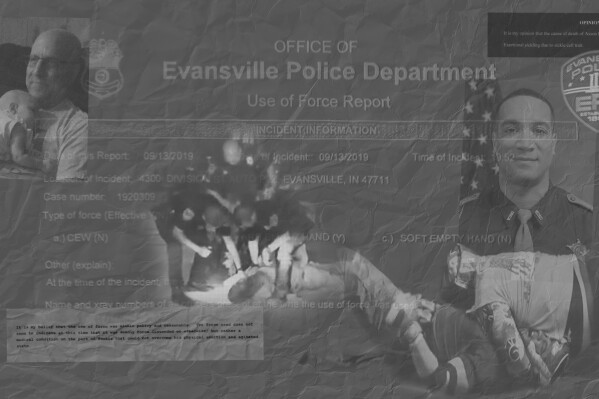Joseph William Holsopple was pronounced dead on Sept. 27, 2020, at a hospital in the city where he was born, Cuyahoga Falls, Ohio. Cause of death: alcoholism. Marital status: divorced. Age: 48.
He graduated high school in Akron, Ohio, in 1990and joined the Springfield Township Police Department in 2000. Over the years, Holsopple married, had two children and bought a house. But his life began to unravel, and in January 2018 he was fired from the department for showing up to work intoxicated and failing a breathalyzer test.
Confidential notes, disciplinary records and letters from fellow officers expressed concern over Holsopple’s alcohol use and the possibility he might have been suffering from post-traumatic stress disorder related to a 2015 death in which he and two other officers used physical force and a Taser on a 24-year-old man. In that encounter, Holsopple forearmed the man in the back of the neck and kept him pinned face down.
The problems that began to develop affected his decision-making and made him a liability in the field, according to his peers.
One officer, in a confidential 2017 memo to the chief, said Holsopple had been reluctant to help other officers trying to detain a suspect. He said Holsopple told him that when he saw the other officers struggling with and shocking the man, “he had a flashback to his recent Taser incident where the suspect subsequently died.”
As part of a larger investigation with The Associated Press, the Howard Center for Investigative Journalism at Arizona State University obtained personnel files of officers involved in deaths after police used physical force or weapons that are not supposed to be lethal.
Holsopple’s personnel records – like those of other officers – reveal the inherently stressful nature of law enforcement work. Police officers regularly experience traumatic events that, experts say, leave them vulnerable to mental health disorders, including depression and PTSD. One risk after a use-of-force death is that officers may quietly deal with trauma in ways that cause their performance or judgment to slip on the streets.
Yet overcoming the stigma of talking about mental health within police culture and addressing the needs of officers are topics rarely emphasized in the ongoing debate over policing.
“Officers have a fear of coming forward to say ‘I have a mental health problem,’” said John Violanti, a former New York State Police trooper and expert on police stress and health at the University at Buffalo.“ And it has to do with stigma. The stigma of mental health in our society is strong; it’s stronger in police work.”
Reporters and Holsopple’s ex-wife texted briefly about this story. But subsequent requests in writing and by phone to interview her went unanswered, as did attempts to speak with Holsopple’s former colleagues.
Reporters also asked the Springfield Township Police Department how it responded to concerns raised about Holsopple. An attorney for the city replied in an email that officers in need of help are directed to local support services specifically tailored to the unique stressors of policing.
Constant stress
Springfield, with some 14,500 residents, is one of nine townships in urban Summit County, approximately 50 miles south of Cleveland. In four years on the police force, Holsopple rose to become a detective, and eventually became the senior detective in charge of investigating and monitoring large caseloads. He specialized in child sex abuse cases and superiors and the city’s prosecuting attorneys praised his thorough investigations and leadership.
“His job knowledge and experience are exceptional,” a superior wrote in Holsopple’s evaluation in February 2015. “He is respected for his cases, knowledge, and his ability to be a solid prosecuting witness in court.”
The same evaluation also recommended that Holsopple rotate out of the detective bureau to take a break from the constant stresses of his assignment.
Holsopple moved into patrol. It was there that in September 2015 he and two other officers responded to a 911 call for Jordn Miller. According to court records, Miller’s mother had requested help for her 24-year-old son. She explained he had a history of mental illness and was suffering a severe “psychotic break,” but was unarmed and not dangerous.
Officers found Miller sitting in someone else’s Jeep, whose owner and others were holding the doors shut to contain him. Police pulled him out and forced him to the ground face down, setting off a minutes-long struggle to handcuff Miller. Another officer kicked and shocked Miller with a Taser twice, as Holsopple – who outweighed Miller by at least 80 pounds – pinned him, according to records and testimony taken as part of a lawsuit that Miller’s family eventually settled out of court. Holsopple also struck Miller on the base of his neck with a forearm and laid on top of him. A sergeant arrived and pressed her foot into Miller’s upper back a few times, fearing he was lifting his head and shoulders to again bite one of them. After Miller was handcuffed face down, a position that for decades has been known to carry risks to breathing and heart function, he became still. He died two days later, on Sept. 10, 2015.
Within a few weeks, the police chief wrote that his review found “no evidence or reports that any officer violated policy” and “minimal force” was used. The Summit County prosecutor’s office similarly found in May 2016 that the force was “justified, reasonable and appropriate” and added that it did not cause Miller’s death. The county medical examiner’s office was less definitive, classifying the death as “undetermined” because of its uncertainty over the contributions that restraint asphyxia, drug use and his unspecified mental illness may have played.
Holsopple recounted the incident in a deposition taken for the Miller family’s lawsuit. He described how Miller’s body immediately went limp after he was shocked, and how he held Miller’s head while the other two officers rubbed his sternum and checked his pulse.
Following Miller’s death, confidential memos and disciplinary records started to appear more regularly in Holsopple’s personnel file. He was habitually late and missing entire shifts. Other officers saw a “decline in his work performance” and felt that he was “avoiding calls by not being first on the scene.”
According to a confidential note a sergeant submitted on April 19, 2017, a suspect Holsopple had helped apprehend accused him of being drunk. In another confidential memo in December 2017, the same officer wrote that he thought Holsopple might still be struggling with Miller’s death. Two days later, yet another officer said he was writing out of concern for both Holsopple and the department.
“Being that I have also been through an in custody death I know that it is not an easy thing to live through or recover from,” the officer wrote. “I believe if the incidents I have been told about are correct that he may be suffering from some form of PTSD and may need professional help.”
Asked about support for police facing mental health challenges, Andrea Ziarko, an attorney for Springfield Township, emailed that officers are directed to the Safety Forces Support Center, a local nonprofit which focuses “on the unique job stressors that law enforcement personnel experience, which can have significant impact on their physical, mental and emotional health.”
Destigmatizing mental health
Amid public concern over force in policing, less attention has been paid to officer mental health.
In 2020, the research journal Occupational and Environmental Medicine reported that “one in four police officers screened positive for hazardous drinking, one in seven met criteria for PTSD and depression, and one in 10 met criteria for an anxiety disorder or suicidal ideation.” The report was based on a review of police mental health studies published globally over 40 years.
Joseph Orgo, a retired police detective from Newark, New Jersey, said when he was an officer, there were few resources available. Orgo is now a mental health counselor with Cop2Cop, a state-funded law enforcement crisis hotline that provides officers with peer support, counseling and other mental health services.A 2019 Department of Justice report that evaluated promising mental health and wellness strategies said Cop2Cop was “a strong candidate for replication” beyond New Jersey.
Orgo said a big reason that Cop2Cop has fielded over 80,000 calls since it launched in 1999 is because it promises confidentiality. There’s also been a change in attitude among many police, which Orgo attributed to a younger generation of leaders “more educated about mental health.”
Departments have tried to implement programs and protocols to flag officers who are suffering from or at risk of mental health problems. These management tools can help departments spot possible symptoms, such as alcohol abuse, tardiness or frequent sick days, said Bill Terrill, an Arizona State University professor and criminology expert.
But these programs are often ineffective because of the culture prevalent in most police departments, Terrill said, calling it “a historical attitude of taking care of yourself, not showing weakness, not reaching out for help, certainly not getting counseling.”
___
This story was produced by the Howard Center for Investigative Journalism at Arizona State University’s Walter Cronkite School of Journalism and Mass Communication. The Howard Center is an initiative of the Scripps Howard Fund in honor of the late news industry executive and pioneer Roy W. Howard. Contact us at [email protected] or on X (formerly Twitter) @HowardCenterASU.
Disclaimer: The copyright of this article belongs to the original author. Reposting this article is solely for the purpose of information dissemination and does not constitute any investment advice. If there is any infringement, please contact us immediately. We will make corrections or deletions as necessary. Thank you.



